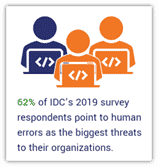Since the beginning of time, trust and recognition have been essential components of human relationships, prompting early humans to devise means of recognizing one another through signs, facial traits, names, and, more recently, official identification and passports. With the emergence and widespread usage of the internet, the concept of authentication has grown extremely sophisticated. Administrators sit behind screens, unable to authenticate the identity of unseen users by sight, name, or signature; instead, they rely on technology to secure their networks from fraudulent users who want to bypass authentication procedures.
The value of strong passwords cannot be emphasized enough. They keep your sensitive personal and business information private by protecting your electronic accounts and gadgets from illegal access. Your information will be better protected from cyber dangers and hackers if your password is more complicated. Let us look at some information about passwords in cybersecurity and digital authentication to see what works and what does not, as well as how authentication should change to support our online future.
What is Password Security?
Passwords are the first line of defense for your computer and personal information against unauthorized access. Your computer will be safer from hackers and bad software if your password is strong. For all accounts on your computer, you should use strong passwords.
The combination of policies, processes, and technology that make passwords and authentication systems more secure is known as password security. Knowing how to safeguard passwords is crucial. A password is a form of secret authenticator that must be memorized. It is essentially a secret that only you should know that allows you to verify yourself to third parties. Cryptographic devices, one-time passwords or PINs, and key access cards are all instances of authenticators.
What Is the Importance of Password Security?
The percentage of International Data Corporation (IDC) survey respondents who claim human errors are the top hazard to enterprises is depicted in this password security image. There are three drawings of people using computers, two of which are colored in a disturbing color. 
Human error is a major problem, and it will continue to be so as long as firms employ people. Humans make mistakes, and users are no exception. (No one is flawless, no matter what your mother told you as a child.) Data from an IDC report backs up this issue.
According to an IDC analysis, user error constitutes the greatest cyber danger to their firms for over two-thirds (62%) of IT and non-IT respondents in their 2019 poll. And the employees who caused the most alarm are your average users, not executives or those with special access credentials.
What is Authentication?
In the context of computer systems, authentication refers to the assurance and validation of a user’s identification. A user must authenticate his or her identity and authorization to access data stored on a network before attempting to access it. A user must supply unique log-in credentials, such as a username and password, before connecting onto a network, a practice aimed to safeguard a network against penetration by hackers. In recent years, authentication has been expanded to include extra personal information from the user, such as fingerprints, to safeguard the account and network from those with the technical expertise to exploit weaknesses.
How does Security interact with Authentication?
Authentication uses a variety of methods to authenticate a user’s identification, including data, passcodes, QR codes, passwords, pass cards, digital signatures, fingerprint, retinal, face, and voice scans. A secure web gateway and the implementation of numerous, integrated security safeguards and solutions, such as next-generation firewall and endpoint protection, are frequently used to enable proper authentication.
Allowing users access to systems and apps is now possible thanks to authentication. But wait, there is more! Once the system has identified who the users are, restrictions can be implemented to limit where they can go, what they can do, and what resources they have access to. This is referred to as permission.
Authorization is crucial since it ensures that users do not have access to more systems and resources than they require. This also allows you to spot when someone is attempting to access something they should not be. For example, maintaining patient confidentiality by only allowing medical personnel and not administrative people access to patient records.
How to Protect Against Large-Scale Data Breaches?
If your company still uses passwords for user authentication, it is critical that you utilize more than just encryption to store your passwords. You may improve the overall security by:
- Passwords should be Hashed: Your passwords are hashed into a random string of characters. It is incredibly tough to decrypt the information without the key once the data has been hashed. Because passwords do not need to be read back, this is extremely beneficial. When people log in, the same hashing is used, and the information on file is compared.
- Using Password Salting: This method adds an additional value at the end of your passwords, making it more difficult to figure out what the actual credential is. When salt is applied, for example, the password “admin” becomes “admin+salt.” The salt supplied to each password should be random and unique as an extra security measure. Salting is usually done after a password has been hashed, therefore the two processes frequently work together to give further layers of security. You are adding new security to your database by salting and hashing your passwords, which makes decoding the data and obtaining access to user information more difficult.
It is important to remember, too, that as our password-based technology advances, thieves’ tools frequently follow close behind. Even after they have been salted and hashed, some hackers have figured out how to execute brute-force attacks on passwords!
Please reach out to us if you need more information or assistance with ensuring proper passwords are in place by users and adding additional layers of security for each user by contacting Frank Stephens at [email protected] or 847-894-6304.
